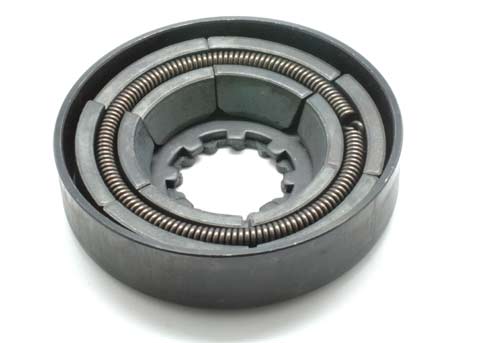Centrifugal Dry Clutch 14 tooth sprocket to suit 420 pitch chain, fits a 25 mm shaft, diameter 110 mm, Length of centre shaft bush 59 mm
- The friction material & arrestor spring(s)
- The transmission plate & central shaft. (central shaft not shown. Picture below shows friction material and spring installed)

In the picture above you can see the friction material installed onto the transmission plate. You can see the transmission plate splines in the centre of the plate. The central shaft (not shown) slots into these splines and slides onto the crankshaft of the engine. It rotates with the engine because it is keyed and the key slots into the keyway on the crankshaft.
The drum sits over this material and is large enough so that the material does not contact the drum when it is fitted. You can rotate the drum freely when the unit is assembled as the friction material does not contact the drum.
As the speed of the crankshaft rotation increases (RPM increases) there is more and more centrifugal force on the friction material.
The spring holds them together in a tight circle and they do not touch the drum.
As the force pushing the friction material away from the centre increases to a point that it is greater than the force applied by the spring, the friction material starts to move outwards and contacts with the drum.
This begins to happen somewhere between 1400rpm and 1800rpm on the standard DRY CLUTCHES. At this point, the drum is still slipping on the friction material because the amount of force is not great enough to overcome the friction from the back wheels. The more weight, the more friction. When the drum slips, it creates heat. This is the biggest CON for the Dry Centrifugal Clutch.
NOTE: DRY CLUTCHES SHOULD NOT BE IDLED!
ONE MORE IMPORTANT THING TO NOTE IS THAT AFTER THE FIRST USE, SOME HEAT WILL INEVITABLY BE TRANSFERRED TO THE SPRING AND IT WILL STRETCH SLIGHTLY. FROM THIS POINT ON, AT IDLE, THE CLUTCH WILL SLOWLY BEGIN TO ENGAGE AT IDLE SPEED - THE HIGHER THE IDLE SPEED, THE MORE THE ENGAGEMENT WHICH WILL ACCELERATE WEAR.
At 2000rpm the friction material has so much centrifugal force applied to it that the spring can no longer arrest the material and it completely contacts the drum. This is considered it's FULLY ENGAGED rpm. Power is now transmitted directly through the chain to the rear drive sprocket and no further heat is created.